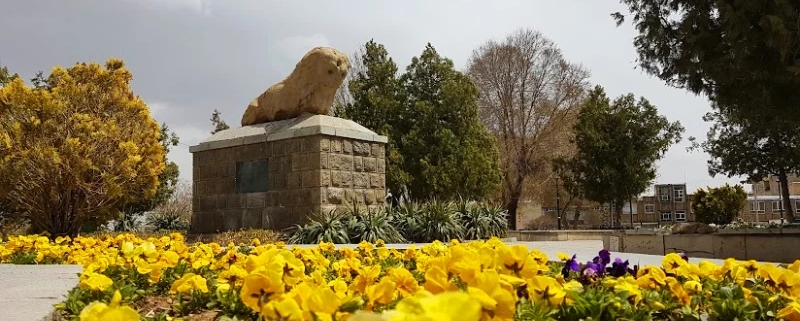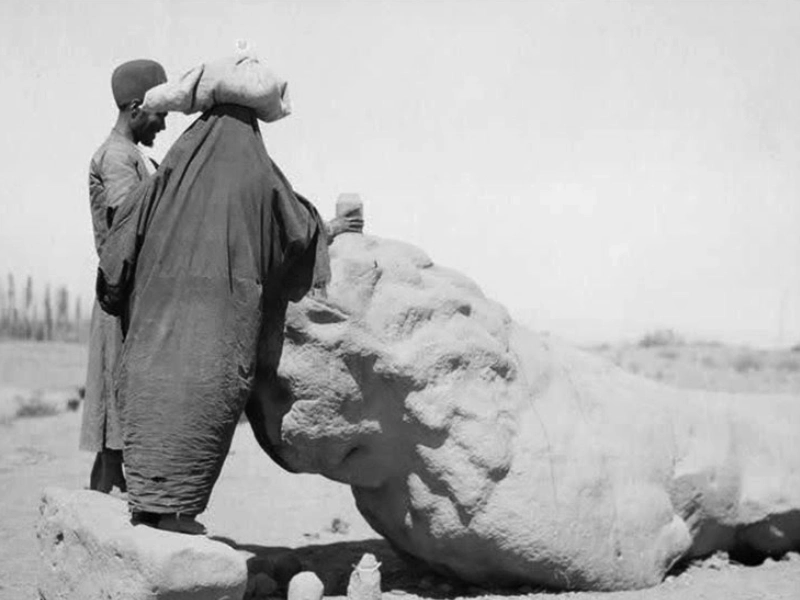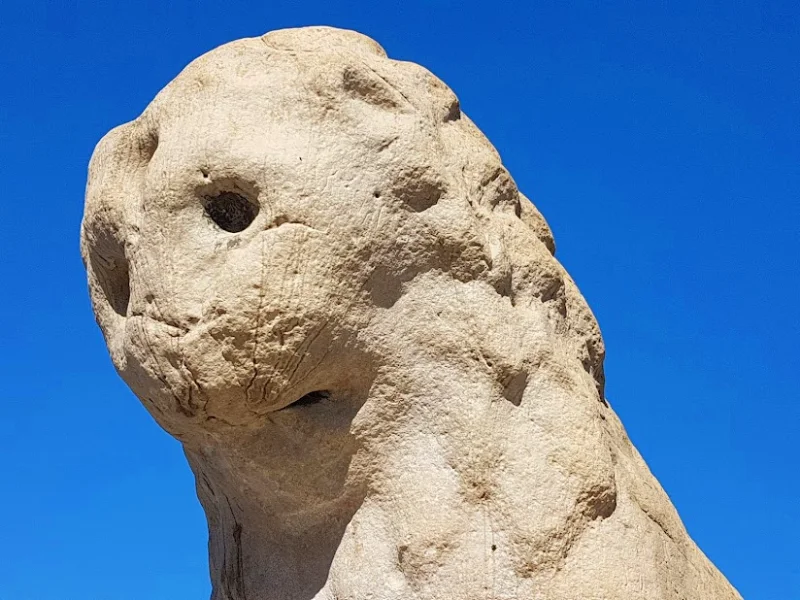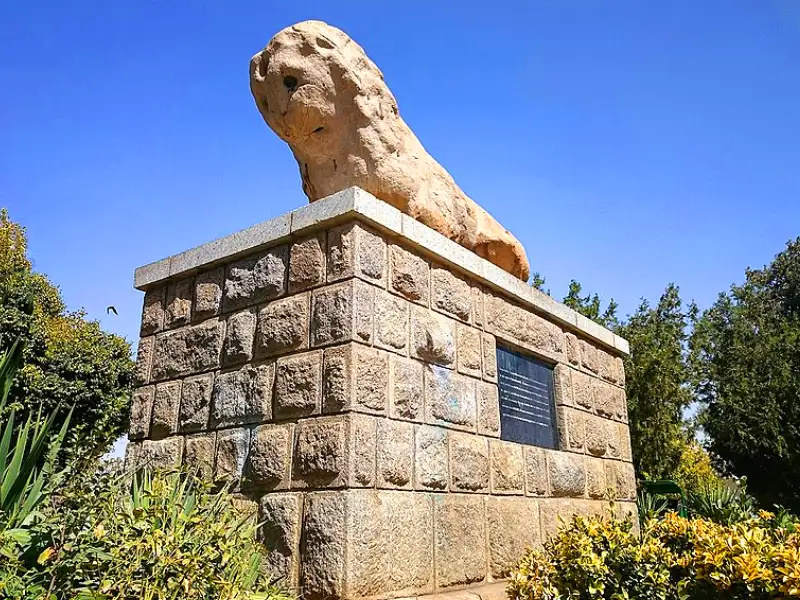Hamedan Stone Lion Statue (History, Meaning, Photos)
The Stone Lion of Hamedan, an ancient and iconic monument, is one of the oldest sculptures in Iran, standing as a symbol of the city’s rich historical and cultural heritage. Located on a hill overlooking Hamedan, the lion is believed to date back to the Parthian or Median era, reflecting the skill and artistry of early Iranian civilizations. Though time has weathered the lion, its majestic presence continues to captivate visitors, offering a glimpse into Iran’s deep-rooted past and its artistic achievements. Let’s learn more about this historical statue!
About Hamedan Stone Lion Statue
When visiting the Stone Lion Statue in Hamedan, tourists will encounter a relic that stands as a reminder of the city’s ancient past. Perched on a hilltop. While the lion has lost some of its original features due to centuries of exposure to the elements, its robust form and enduring presence still evoke a sense of awe.
The surrounding area offers a panoramic view of Hamedan, making the site not only a historical landmark but also a scenic vantage point for visitors. Travelers can reflect on the monument’s significance, enjoy the peaceful surroundings, and connect with a piece of Iran’s cultural history.
Hamedan Stone Lion Statue Meaning
The Hamedan Stone Lion is believed to symbolize strength, protection, and power, representing a guardian figure for the ancient city of Hamedan. Its imposing form reflects the importance of lions in ancient Persian culture, where they often symbolized authority and served as protectors of cities and royal structures.
Hamedan Stone Lion History
The Hamedan Stone Lion, known as Shir-e Sangi, holds a deep historical significance that stretches back over two millennia. It is believed to have been sculpted during the Parthian or Median era, although the exact origins remain a topic of debate among historians. Some accounts suggest that the statue was part of a pair of lions positioned to guard one of the ancient gates of the city.
Others speculate that it might have been erected to commemorate a significant battle or as a funerary monument for a king or a noble figure. Regardless of its original purpose, the lion has withstood the test of time, becoming a symbol of Hamedan’s ancient roots and artistic heritage.
Throughout history, the Stone Lion has witnessed the rise and fall of empires, surviving invasions, and changes in ruling powers. The statue was damaged during the Arab invasion of Iran in the 7th century, leaving behind only one of the original two lions. Later, it was rediscovered and restored by local efforts, preserving it as a cultural landmark for future generations.
Today, it remains a point of pride for the people of Hamedan, drawing historians, archaeologists, and tourists alike who are eager to connect with the city’s ancient past and admire this enduring symbol of Iran’s rich heritage.
Hamedan Stone Lion Architecture
The architecture of the Hamedan Stone Lion reflects the craftsmanship and artistic sensibilities of ancient Iranian civilizations. Carved from a single block of stone, the lion was originally part of a larger architectural structure believed to have stood as a guardian figure at the gates of the city. The sculpture’s design, though now weathered, hints at the Parthian or Median artistic style, characterized by robust and stylized forms.
The lion’s body is bulky and imposing, suggesting strength and power, while its face, though eroded by time, still carries traces of intricate detailing around the mouth and eyes. This attention to detail would have conveyed a sense of majesty and authority to those entering the city, making the lion not only a work of art but also a symbol of protection and dominance.
In its original form, the Stone Lion likely featured more elaborate details, such as clearly defined muscles, facial features, and possibly even decorative carvings that have been lost over the centuries. The statue’s sheer size and weight required significant engineering and architectural skills, demonstrating the capabilities of ancient stone masons in Hamedan. Positioned on a hilltop, the lion’s placement also seems deliberate, allowing it to dominate the landscape and serve as a visible marker from afar.
Today, despite the wear and tear, the lion’s solid form and enduring presence still convey its architectural significance, offering a rare glimpse into ancient Iranian stone carving techniques and the symbolic importance of monumental sculptures in historical cityscapes.
Hamedan Stone Lion Location
The Hamedan Stone Lion is located in the ancient city of Hamedan, situated in the western part of Iran. The statue rests on a hill known as “Lion Hill” or “Kuh-e Shir,” offering visitors a scenic view of the surrounding city and landscape. Its exact location is near the southern entrance of the city, not far from the bustling city center, making it easily accessible for tourists (Location on map).
The site can be reached by traveling to Bu-Ali Sina Street and taking a short walk from there, where visitors will find the iconic Stone Lion amidst a quiet and historic setting. Its prominent position on the hilltop allows it to stand as a visible landmark, drawing tourists to this culturally significant monument.
Hamedan Stone Lion Ticket Price
Visiting the Hamedan Stone Lion is typically free of charge, as it is an open-air monument accessible to the public without the need for an entrance ticket. The statue is situated on a hill in a public area, allowing both locals and tourists to explore the site freely at any time.
As a cultural and historical landmark, it serves as an inviting destination for those looking to experience a piece of Iran’s ancient heritage without the cost of admission. However, visitors may need to budget for transportation or any guided tour services they might choose to enhance their experience.
Nearby Attractions
The area surrounding the Hamedan Stone Lion offers several attractions that highlight the city’s rich historical and cultural legacy. Just a short distance away is the Tomb of Avicenna, the renowned Persian physician and philosopher, which is one of Hamedan’s most iconic landmarks. This beautiful mausoleum, with its towering spire and museum, provides insight into the life and achievements of Avicenna, making it a must-visit for those interested in Persian intellectual history.
Another nearby attraction is the Alavian Dome, an architectural masterpiece from the Seljuk era, known for its intricate stucco work and fine Islamic designs. These attractions, along with the Stone Lion, create a historical circuit that connects visitors to different eras of Iranian history.
Ecbatana, the ancient capital of the Median Empire, is located near the Stone Lion in Hamedan and offers a fascinating glimpse into Iran’s early history. Visitors to the site can explore the remnants of this ancient city, including its impressive walls and archaeological ruins, which once housed kings and served as a political center. With its historical significance and proximity to the Stone Lion, Ecbatana is a must-see attraction for those interested in the ancient civilizations of Iran.
Additionally, the bustling bazaar of Hamedan is located not far from the Stone Lion, offering a vibrant experience for tourists who wish to immerse themselves in local culture. The bazaar is a lively marketplace where visitors can find traditional handicrafts, spices, textiles, and souvenirs, reflecting the city’s rich heritage.
Other nearby attractions include Ganjnameh, a set of ancient inscriptions from the Achaemenid era carved into the rocks, as well as the scenic Abbas Abad Hill, offering a beautiful view of the city and a peaceful retreat. Together, these sites create a diverse experience for tourists, combining historical exploration with cultural immersion.
Last Words
The Hamedan Stone Lion stands as a timeless symbol of the city’s ancient heritage, offering visitors a unique opportunity to connect with Iran’s deep historical roots. From its rich architectural design to its strategic location atop Lion Hill, the statue continues to captivate those who visit, serving as both a cultural monument and a reminder of Hamedan’s significance throughout history.
Surrounded by other important attractions, such as the Tomb of Avicenna and the bustling city bazaar, the Stone Lion provides a gateway to exploring the broader historical and cultural landscape of Hamedan. A visit to this enduring relic is not only a journey into the past but also a meaningful experience that celebrates Iran’s artistic and historical achievements.
Are you planning to travel to Iran and looking for an Iran travel agency? Check out our Iran tours. Read about more Things to Do in Hamedan.









Leave a Reply
Want to join the discussion?Feel free to contribute!